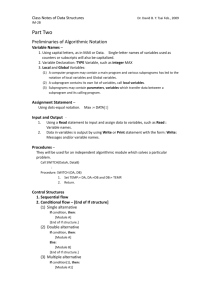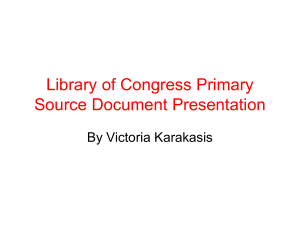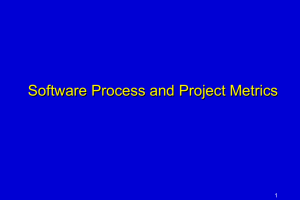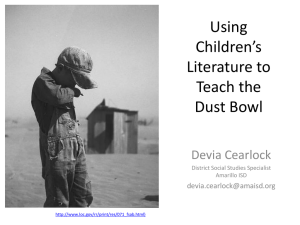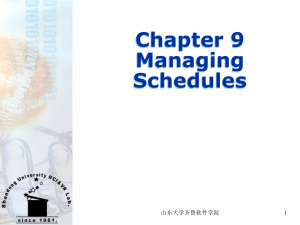File
advertisement
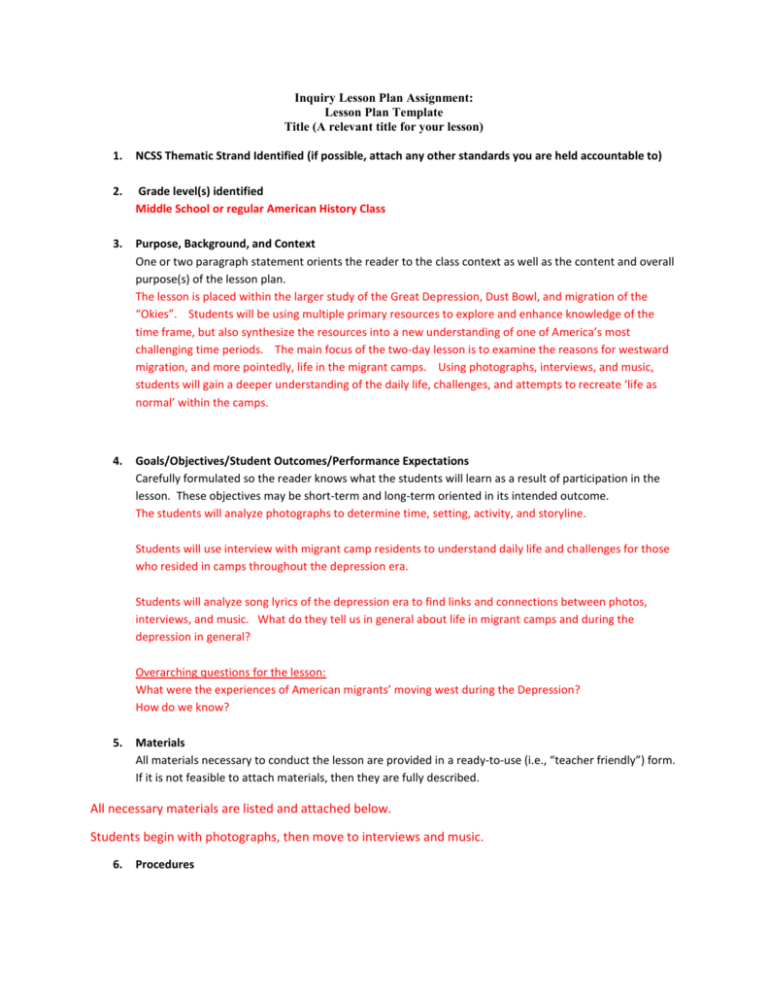
Inquiry Lesson Plan Assignment: Lesson Plan Template Title (A relevant title for your lesson) 1. NCSS Thematic Strand Identified (if possible, attach any other standards you are held accountable to) 2. Grade level(s) identified Middle School or regular American History Class 3. Purpose, Background, and Context One or two paragraph statement orients the reader to the class context as well as the content and overall purpose(s) of the lesson plan. The lesson is placed within the larger study of the Great Depression, Dust Bowl, and migration of the “Okies”. Students will be using multiple primary resources to explore and enhance knowledge of the time frame, but also synthesize the resources into a new understanding of one of America’s most challenging time periods. The main focus of the two-day lesson is to examine the reasons for westward migration, and more pointedly, life in the migrant camps. Using photographs, interviews, and music, students will gain a deeper understanding of the daily life, challenges, and attempts to recreate ‘life as normal’ within the camps. 4. Goals/Objectives/Student Outcomes/Performance Expectations Carefully formulated so the reader knows what the students will learn as a result of participation in the lesson. These objectives may be short-term and long-term oriented in its intended outcome. The students will analyze photographs to determine time, setting, activity, and storyline. Students will use interview with migrant camp residents to understand daily life and challenges for those who resided in camps throughout the depression era. Students will analyze song lyrics of the depression era to find links and connections between photos, interviews, and music. What do they tell us in general about life in migrant camps and during the depression in general? Overarching questions for the lesson: What were the experiences of American migrants’ moving west during the Depression? How do we know? 5. Materials All materials necessary to conduct the lesson are provided in a ready-to-use (i.e., “teacher friendly”) form. If it is not feasible to attach materials, then they are fully described. All necessary materials are listed and attached below. Students begin with photographs, then move to interviews and music. 6. Procedures Students will be in groups of four. They will begin by looking at the series of photos below. For each photo they are to record the following (number each photo for future reference): -what, if any, writing is in the photo? What does it say? -who is in the picture? (specific people or groups) -what action is taking place in the photo? -what time period is it? Are there clues as to the time period? When they have analyzed each photo, they are to write narrative statements about the series of photos: -what are they about? -where are they? -what do you know about them based on the series of photos? Discuss as a class the findingsNext, students will divide and begin listening to various camp interviews explaining many different aspects of migrant life. Students will record connections they find between interviews and photographs (for instance, one photo shows a baseball field and one interviewee discusses the parks at the camps). The multiple links to interviews are listed/attached below. Finally, students will divide and listen to the multiple music links attached below. Students are to once again make connections between music, photos, and interviews. Students will use the analysis sheet attached for all audio recordings. http://www.archives.gov/education/lessons/worksheets/sound_recording_analysis_worksheet.pdf http://www.loc.gov/collection/todd-and-sonkin-migrant-workers-from-1940-to-1941/about-thiscollection/ http://cdn.loc.gov/master/afc/afc1985001/afc1985001_p001/0001r.jpg http://cdn.loc.gov/master/afc/afc1985001/afc1985001_p004/0001r.jpg http://cdn.loc.gov/master/afc/afc1985001/afc1985001_p022/0001r.jpg http://cdn.loc.gov/master/afc/afc1985001/afc1985001_p023/0001r.jpg http://cdn.loc.gov/master/afc/afc1985001/afc1985001_p009/0001r.jpg http://cdn.loc.gov/master/afc/afc1985001/afc1985001_p007/0001r.jpg Interview on discrimination against Mexican-Americans in camps: interview http://www.loc.gov/item/toddbib000358/ Interview about FSA camp governance, camp work, non-FSA migrant camps, labor issues, attitude toward "Okies." El Rio, 1941 http://www.loc.gov/item/toddbib000359/ Interview on picking lemons, 1941 http://www.loc.gov/item/toddbib000360/ Interview about closing migrant camps http://www.loc.gov/item/toddbib000361/ Interview about a camp party -1941 http://www.loc.gov/item/toddbib000346/ Interview describing migrant camps (ball park) http://www.loc.gov/item/toddbib000335/ Interview in camp http://www.loc.gov/item/toddbib000076/ Interview on why they went to California http://www.loc.gov/item/toddbib000092/ http://www.loc.gov/item/toddbib000188/ Sermon on cooperation http://www.loc.gov/item/toddbib000143/\ Songs of the Great Depression http://www.loc.gov/item/toddbib000046/ http://www.loc.gov/item/toddbib000170/ 7. Assessment of Outcomes Assessment of the lesson will occur through class discussions initially. Groups will then synthesize the information they have gathered and create one of three things: -A new song that incorporates life in the migrant camps -A detailed diary entry explaining daily existence, challenges, and hopes of migrants -A letter back home to someone in Oklahoma explain his or her experiences and convincing them to either move west or stay home. 8. Extensions and Adaptations Students will explore the experience of migrant workers today and create a Venn diagram or comparative analysis of the two groups; the focus will be on continuity and change over time.
